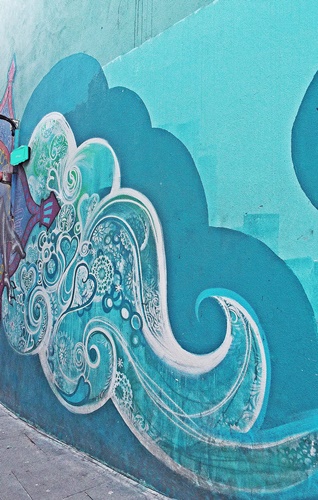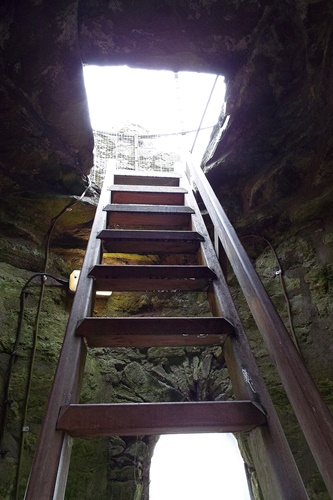In which I find a nice little park, suffer a disappointment and find some lovely stained glass windows…
The last full day of the holiday arrived dull and grey but not wanting to waste it by staying in Roscrea I decided to take myself off to Adare which was, according to various sources of information (and I quote) ”one of Ireland’s prettiest villages with its main street lined with unique thatched cottages” – even on a dull day it sounded like it was worth a look. To get there I had to change buses at Limerick ; the coach from Roscrea to Limerick passed through Nenagh and as there was a shop there I wanted to go back to I decided to break my journey, get what I wanted then continue to Limerick on the next coach. With two different bus companies running between Roscrea and Limerick, and staggered bus times, planning my journey was like planning military manoeuvres and it would have worked out well if everything had gone to that plan but it didn’t.
The first coach arrived twenty minutes late in Roscrea so I only had just enough time to get what I wanted from the shop in Nenagh before the second coach arrived, however I needn’t have rushed after all as that one turned up forty five minutes late. Of course when I got to Limerick my intended bus to Adare had gone ages before so I had to wait fifty minutes for the next one, however I finally got there albeit quite a lot later than I’d wanted to. As it turned out though, arriving late in Adare didn’t really matter as I didn’t stay as long as I’d expected to.
The bus put me off at the entrance to Adare Town Park, it looked like quite an attractive place so I decided to have a look round there first. With lots of trees and lawned areas, a small stream running along one side, a thatched gazebo and plenty of benches it was a very pleasant place to walk round and would probably be very pretty in spring and summer.
On the way into the village, and just up the road from the park, I’d noticed a row of thatched cottages and as my sources of information had said the main street was lined with them I expected to see many more, but looking down the road all I could see were normal buildings and shop frontages. Across the road from the park was a heritage centre and tourist information place so I went in there to ask, only to be told that the cottages up the road were the ones I was looking for. So much for the main street being ”lined with thatched cottages” – one row and that was it. I felt like saying that whoever produced and printed the information should be prosecuted under the Trades Description Act!
When I went to have a proper look at the cottages I found that most of them had been turned into little businesses ; there was a café, a gift shop, a craft shop, two very small restaurants, a bistro and a couple of holiday cottages. Admittedly they did look quite attractive and no doubt in summer, with gardens full of flowers, would look very pretty, but having expected to see a quaint little village full of them I was rather disappointed to find that those were the only ones.
Next door to the heritage centre was Holy Trinity Abbey Church, the only Trinitarian Abbey in Ireland. There is no record of the exact date of its foundation but it’s believed to have been established between the years 1230 and 1240. Dissolved in the 1560s the church eventually became a ruin but in 1809 the 2nd Earl of Dunraven restored the building and gave it to the Catholic Church. No major structural changes have taken place since 1884 although there have been several modifications and some development in the years since then, and in summer 2010 a programme of critical repairs was undertaken to preserve the church.





From the church a short walk along to the far end of the main street produced just one more thatched cottage set back from the road in a wrap-around garden, then with nothing else to see in the village and the afternoon still dull I decided I may as well get the next bus back to Limerick. I had about half an hour to wait though so I went to look round inside the heritage centre and found a very bright and pleasant looking cafe ; I just had time for coffee and cake so I ordered a slice of Banoffee pie and a latte, and was pleased to see that this time the coffee came in a proper glass mug.

By the time I got back to Limerick the daylight was fading rapidly. The bus from Adare had taken me to the bus station but the coach back to Roscrea left from Arthur’s Quay park, a good walk through the city centre, and as I had an hour to kill I thought I may as well take my time in going there and get a few evening shots en route. Past Arthur’s Quay the front wall of the Hunt Museum was lit with green lights so I got a shot of the horses against the coloured background then walked along to where I could see the illuminated side of the castle ; I even had time to cross the bridge, walk along the riverside at Clancy’s Strand then re-cross the river at the next bridge, where my final shot was one of the illuminated 1916 war memorial.







Relaxing by the fire later that evening I went through the photos I’d taken while I’d been out. It had been an odd sort of a day and I hadn’t been particularly impressed with Adare ; I’d only been there for just over an hour and that had been enough so I doubted I would ever go back there again, however since getting back home I’ve found out about another couple of places there which, on a nice day, may be worth visiting so who knows? – maybe I’ll make a return visit sometime in the spring or summer months.
































































































































































































































































































































